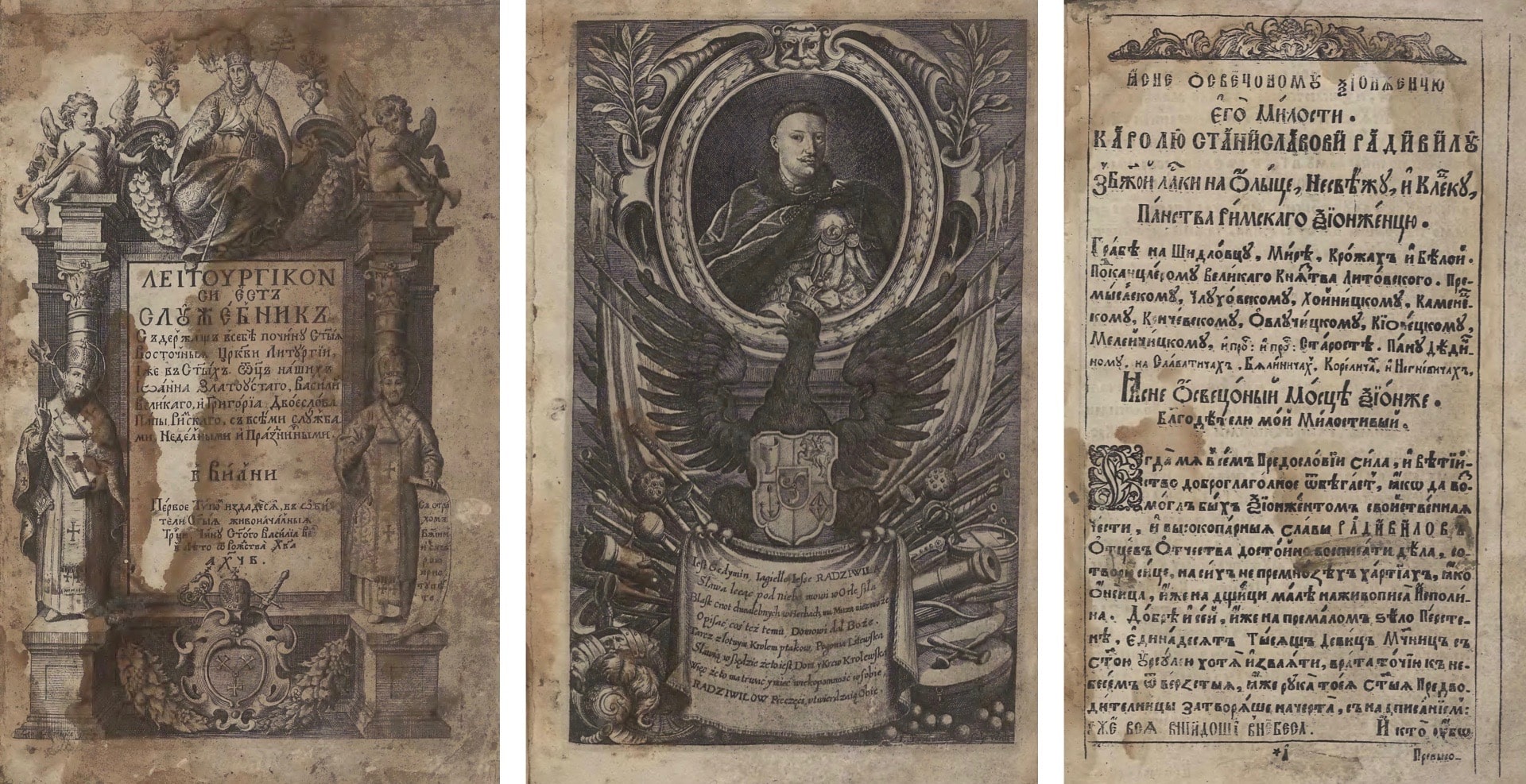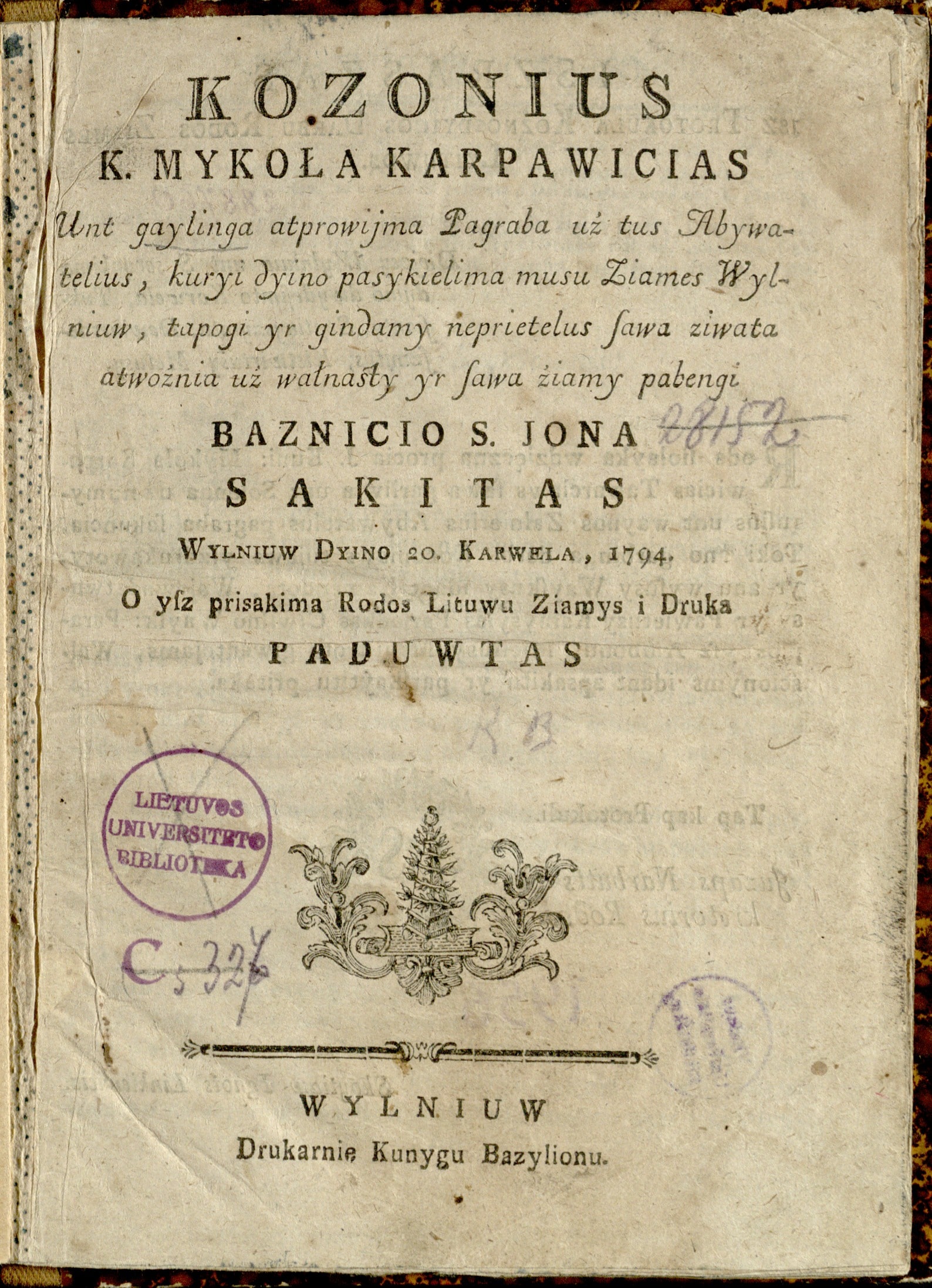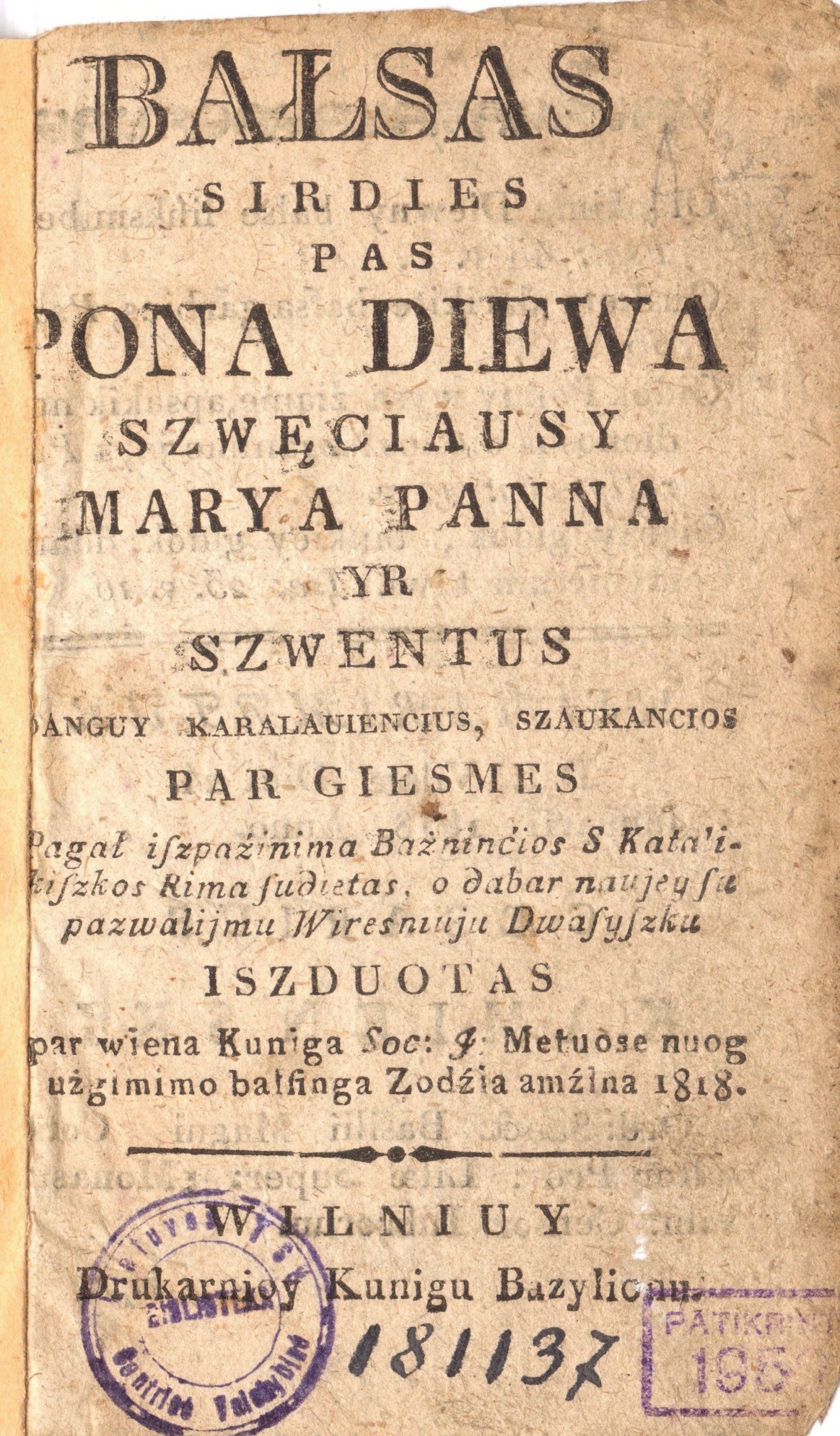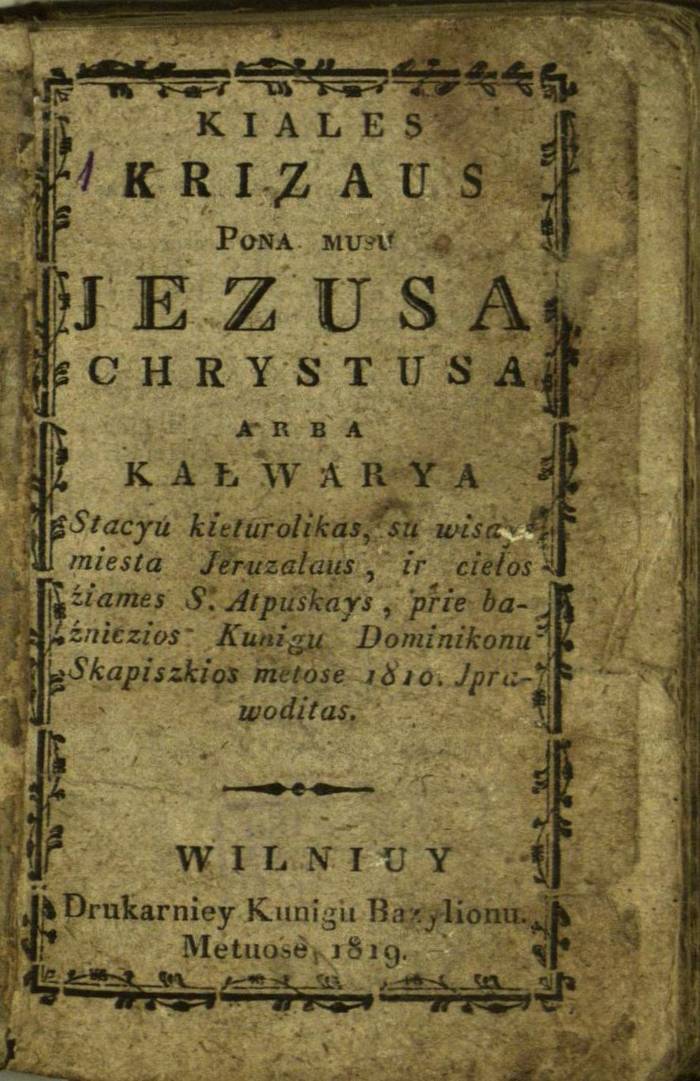The Order of St. Basil the Great was among the most active monastic congregations in the Polish-Lithuanian Commonwealth in publishing activities. Only the Jesuits and the Piarists managed to publish a greater number of titles there than the Basilians.1Мария Пидлыпчак-Маерович, “Издания на литовском языке василианских и иезуитских типографий”, in: Исторический путь литовской письменности, ред. Юозас Будрайтис, et al., Вильнюс: Институт литовского языка, 2005, с. 34. One of the six Basilian printing houses functioned in Vilnius from the 17th century to the 1830s, and it was the first such institution of a monastic order and one of the first in the Uniate Church. In general, to the middle of the 17th century the city remained an important publishing center of the Commonwealth, in which there were 13 printing houses. In 1624, the publishing house of Leon Mamonicz was sold to the monks of Holy Trinity Monastery.2Jakub Niedźwiedź, Kultura literacka Wilna (1323–1655): retoryczna organizacja miasta, Kraków: Universitas, 2012, s. 195, 197, 202. In four years, in 1628, they published their first book, and so began the Basilians’ publishing activities in Vilnius, which lasted until 1839 inclusively.
The most intensive period of the publishing activities of the Vilnius Basilians in the 17th century was from the 1640s to the start of the 1650s. During this time, 22 titles were published, including the panegyrics of the archimandrite of Holy Trinity Monastery, Aleksy Dubowicz.3Maria Pidłypczak-Majerowicz, Bazylianie w Koronie i na Litwie. Szkoły i książki w działalności zakonu, Warszawa, Wrocław: Państwowe Wydawnictwo Naukowe, 1986, s. 59. During the Muscovite invasion in the 1650s, the publishing house suffered damage, and the publication of books in Cyrillic halted until 1670, when they published the Chasoslov (Book of the Hours) in the Church Slavonic Language [1].4Михайло Ваврик, “Церковні друкарні й видання в Укр. кат. церкві 17-го стол.”, in: On the 50th Anniversary of Analecta OSBM (series: Analecta OSBM, сер. 2, ч. 2: Articuli Documenta Miscellanea Bibliographia, т. 9, ч. 1–4), Romae: PP. Basiliani, 1974, с. 119–120.
The largest publishing project of the Basilian publishing house in Vilnius in the 17th century was to be a new Sluzebnik (liturgical service book for priests), intended to regulate and reinforce the changes in liturgical practices of the Uniate Church. They prepared this book for publication at the start of the 1690s, but Metropolitan Cyprian Żochowski held up publication, and at his orders they moved part of the publishing equipment from Holy Trinity Monastery to the Suprasl monastery. Sluzebnik finally appeared in Vilnius in 1692.5Mikoła Nikołajew, “Drukarnia klasztoru św. Trójcy w Wilnie w świetle nowych dokumentów archiwalnych”, in: Książka ponad podziałami, Lublin: Wyd-wo Uniwersytetu Marii Curie-Skłodowskiej, 2007, s. 175–177. Because of various circumstances, the Basilians’ publishing institution was practically inactive until the 1760s.6Joanna Getka, Polskojęzyczne druki bazyliańskie (XVIII wiek), Warszawa: BEL Studio Sp. z o.o., 2013, s. 35.
In 1770, the first verses of young Johann Wolfgang von Goethe (1749–1832), eminent German writer and thinker, were published at the Breitkopf Publishing House in Leipzig. That same year at the same institution, the superior of Holy Trinity Monastery in Vilnius, Samuel Nowicki, ordered through some purchaser fonts for the Basilians, paying a significant sum at that time, 131 florins and 8 grosz, and in 1771, for another order, 89 florins and 12 grosz.7Домет Г. Олянчин, “Торговельні зносини України з Ляйпцігом у XVIII-м ст. (із архівної праці в Ляйпцігові)”, in: Наша культура, Варшава, 1936, т. 2, с. 74. In the monastery’s inventory description of 1774, in addition to a list of printing equipment necessary for quality work, also noted are 73 musical notes and two “lines for notes”,8СПбИИ РАН, колл. 52, оп. 1, ед. хр. 297, л. 14. that is, font supplies for publications with lined notes. Actually, this refers to fonts acquired in the best musical publishing house in Europe at that time, the Breitkopf Publishing House, where in 1754 they started the technology of printing notes with the help of a set of letters.
In the middle of the 1770s, the Uniate monks in Vilnius possessed all the equipment necessary for publishing activity, with which they carried out approx. 200 functions of various printing devices listed in the inventory of 1774. On the premises of the publishing house there were two large tables, small tables for correction and washing forms, a shelf for holding paper, four stools, etc. For book publishing, they used Prussian, French, and Muscovite paper9Ibid., л. 13 об.–15.. In 1787, they again bought new fonts, this time at the Piotr Zawadzki Publishing House in Warsaw.10Zoja Jaroszewicz-Pieresławcew, Druki cyrylickie z oficyn Wielkiego Księstwa Litewskiego w XVI–XVIII wieku, Olsztyn: Wyd-wo Uniwersytetu Warmińsko-Mazurskiego, 2003, s. 118. Clearly, this was for Latin letters, which were used in books in the Latin and Polish languages.
According to the descriptions from the last quarter of the 18th century to the 1830s, the press was located in the basement at the intersection of the southern and western lines of the monastery building (↑). The premises had a stove, eight windows,11СПбИИ РАН, колл. 52, оп. 1, ед. хр. 297, л. 13 об. cabinets of walnut wood, an old oak table, a table clock, a picture, a signal bell, and various special equipment.12LVIA, f. 1178, ap. 1, b. 48, l. 10.
It has still not been determined exactly how many titles (and more so how many copies) the Basilians in Vilnius published throughout the whole period of the existence of the press. According to some reckonings, throughout 1760–1800, in various editions 172 books were published by this Basilian publishing house.13Maria Pidłypczak-Majerowicz, op. cit., s. 60. It is difficult to establish the size of the runs, but the available statistical data give grounds to confirm that it was a true local publishing boom.
From the start of the 19th century, the Vilnius imperial university regulated the publishing house’s functioning. From that time, publishing initiatives were limited to the publication of literature “of the character of textbooks” necessary for Basilian schools (↑). From 1812, when the monastery was used as a military hospital infirmary, the publishing house suffered significant technical damage, material losses, and the loss of books. Regardless of this, throughout some of the following years they managed to return to normal work.14LMAVB RS, f. 41, b. 83, l. 83.
The Polish-language profile of the printing house of Leon Mamonicz conditioned the linguistic orientation of the analogical institution of the Basilians, in which books were published also generally in the Polish and Latin languages. Books there were published more rarely in Church Slavonic, and at the end of the 18th century there were individual examples of books published in Lithuanian (“Samogitian”)15Мария Пидлыпчак-Маерович, op. cit., с. 36. In the inventory of 1823 it was fixed, that press “publish different books in Polish, Ruthenian, Samogitian and Lithuanian languages” (LMAVB, Rankraščių skyrius, f. 41, b. 83, l. 80). and even French (a famous publication “The Akathist to the Mother of God” in the translation of Basilian Hilarion Karpiński [2, 3, 4].16Drukarze dawnej Polski od XV do XVIII wieku, t. 5: Wielkie Księstwo Litewskie, Wrocław, Kraków: Zakład Narodowy im. Ossolińskich, 1959, s. 44. In 1794, the “patriotic” sermon in the Lithuanian language of Michał Franciszek Karpowicz “Kozonius K. Mykoła Karpawicias Unt gaylinga atprowijma Pagraba” was published.17Мария Пидлыпчак-Маерович, op. cit., с. 39.
Works of Basilians or books directly connected with the OSBM made up an insignificant part of the publishing repertoire.18Maria Pidłypczak-Majerowicz, op. cit., s. 178–180. At its press, the Vilnius monks not only published original works, but they also did reprints. In addition to texts of the monks of the order, works of Roman Catholic orders were also published (Benedictines, Dominicans, Jesuits, Carmelites, etc.).19Drukarze dawnej Polski…, s. 43–44; Maria Pidłypczak-Majerowicz, op. cit., s. 181–184, 186. Though the Vilnius publishing house was oriented, above all, to the Latin-Polish book market, Cyrillic publications also became an important part of its publishing repertoire. It’s possible to speak of at least of 75 Cyrillic titles (for comparison, there were 321 titles at the biggest Basilian publishing house at that time, in Pochaiv).20Олена Железняк, “Почаївські видання кириличним шрифтом: 1734-1830”, in: Друкарня Почаївського Успенського монастиря та її стародруки, гол. ред. Олексій С. Онищенко, Київ: НАН України, 2011, c. 162–192; Зоя Ярошевич-Переславцев, “Вильнюсское кириллическое книгопечатание: его судьба и значение”, Vilniaus universiteto bibliotekos metraštis 2015, 2015, p. 303–304. In particular, for the period from the 1760s to the 1830s, researchers count approximately 50 so-called “old rite” publications.21Андрей Вознесенский, Ирина Починская, “Книгоиздание XVIII – первой четверти XIX веков”, in: Андрей В. Вознесенский, Петр И. Мангилев, Ирина В. Починская, Книгоиздательская деятельность старообрядцев (1701–1918). Материалы к словарю, Екатеринбург: Институт русской культуры Уральского государственного ун-та им. А. М. Горького, 1996, с. 8.
Ivan Almes
Išnašos:
| 1. | ↑ | Мария Пидлыпчак-Маерович, “Издания на литовском языке василианских и иезуитских типографий”, in: Исторический путь литовской письменности, ред. Юозас Будрайтис, et al., Вильнюс: Институт литовского языка, 2005, с. 34. |
|---|---|---|
| 2. | ↑ | Jakub Niedźwiedź, Kultura literacka Wilna (1323–1655): retoryczna organizacja miasta, Kraków: Universitas, 2012, s. 195, 197, 202. |
| 3. | ↑ | Maria Pidłypczak-Majerowicz, Bazylianie w Koronie i na Litwie. Szkoły i książki w działalności zakonu, Warszawa, Wrocław: Państwowe Wydawnictwo Naukowe, 1986, s. 59. |
| 4. | ↑ | Михайло Ваврик, “Церковні друкарні й видання в Укр. кат. церкві 17-го стол.”, in: On the 50th Anniversary of Analecta OSBM (series: Analecta OSBM, сер. 2, ч. 2: Articuli Documenta Miscellanea Bibliographia, т. 9, ч. 1–4), Romae: PP. Basiliani, 1974, с. 119–120. |
| 5. | ↑ | Mikoła Nikołajew, “Drukarnia klasztoru św. Trójcy w Wilnie w świetle nowych dokumentów archiwalnych”, in: Książka ponad podziałami, Lublin: Wyd-wo Uniwersytetu Marii Curie-Skłodowskiej, 2007, s. 175–177. |
| 6. | ↑ | Joanna Getka, Polskojęzyczne druki bazyliańskie (XVIII wiek), Warszawa: BEL Studio Sp. z o.o., 2013, s. 35. |
| 7. | ↑ | Домет Г. Олянчин, “Торговельні зносини України з Ляйпцігом у XVIII-м ст. (із архівної праці в Ляйпцігові)”, in: Наша культура, Варшава, 1936, т. 2, с. 74. |
| 8. | ↑ | СПбИИ РАН, колл. 52, оп. 1, ед. хр. 297, л. 14. |
| 9. | ↑ | Ibid., л. 13 об.–15. |
| 10. | ↑ | Zoja Jaroszewicz-Pieresławcew, Druki cyrylickie z oficyn Wielkiego Księstwa Litewskiego w XVI–XVIII wieku, Olsztyn: Wyd-wo Uniwersytetu Warmińsko-Mazurskiego, 2003, s. 118. |
| 11. | ↑ | СПбИИ РАН, колл. 52, оп. 1, ед. хр. 297, л. 13 об. |
| 12. | ↑ | LVIA, f. 1178, ap. 1, b. 48, l. 10. |
| 13. | ↑ | Maria Pidłypczak-Majerowicz, op. cit., s. 60. |
| 14. | ↑ | LMAVB RS, f. 41, b. 83, l. 83. |
| 15. | ↑ | Мария Пидлыпчак-Маерович, op. cit., с. 36. In the inventory of 1823 it was fixed, that press “publish different books in Polish, Ruthenian, Samogitian and Lithuanian languages” (LMAVB, Rankraščių skyrius, f. 41, b. 83, l. 80). |
| 16. | ↑ | Drukarze dawnej Polski od XV do XVIII wieku, t. 5: Wielkie Księstwo Litewskie, Wrocław, Kraków: Zakład Narodowy im. Ossolińskich, 1959, s. 44. |
| 17. | ↑ | Мария Пидлыпчак-Маерович, op. cit., с. 39. |
| 18. | ↑ | Maria Pidłypczak-Majerowicz, op. cit., s. 178–180. |
| 19. | ↑ | Drukarze dawnej Polski…, s. 43–44; Maria Pidłypczak-Majerowicz, op. cit., s. 181–184, 186. |
| 20. | ↑ | Олена Железняк, “Почаївські видання кириличним шрифтом: 1734-1830”, in: Друкарня Почаївського Успенського монастиря та її стародруки, гол. ред. Олексій С. Онищенко, Київ: НАН України, 2011, c. 162–192; Зоя Ярошевич-Переславцев, “Вильнюсское кириллическое книгопечатание: его судьба и значение”, Vilniaus universiteto bibliotekos metraštis 2015, 2015, p. 303–304. |
| 21. | ↑ | Андрей Вознесенский, Ирина Починская, “Книгоиздание XVIII – первой четверти XIX веков”, in: Андрей В. Вознесенский, Петр И. Мангилев, Ирина В. Починская, Книгоиздательская деятельность старообрядцев (1701–1918). Материалы к словарю, Екатеринбург: Институт русской культуры Уральского государственного ун-та им. А. М. Горького, 1996, с. 8. |
Sources of illustrations:
| 1. | Леітоургікон си єстъ слуҗєбникъ съдєрҗащъ в сєбе почину с[вят]ыя Восточныя Ц[е]ркви Литургїи, іжє въ с[вя]тыхъ отецъ нашихъ Іωана Златоустаго, Василиа Вєликаго, и Григорїа Двоєслова Папы Римскаго, съ всеми службами, Нєдєлными и Праздничными…, Wilno, 1692. Held in: MNK, MNK VIII-XVII.221A (Available at: Malopolska Digital Library, http://mbc.malopolska.pl/dlibra/docmetadata?id=82970&from=publication, accessed: 2021 12 01). |
| 2. | [Michał Franciszek Karpowicz], Kozonius K. Mykoła Karpawicias Unt gaylinga atprowijma Pagraba…, Wylniuw: Drukarnie Kunigu Bazylionu, [1794], p. [title page]. Held in: VUB, Retų spaudinių skaitykla, Lr718 (Available at: Vilniaus universiteto biblioteka. Skaitmeninės kolekcijos, https://kolekcijos.biblioteka.vu.lt/islandora/object/atmintis%3AVUB01_000394043#I, accessed: 2021 12 01). |
| 3. | Bałsas sirdies pas Pona Diewa Szwęciausy Marya Panna yr szwęntus danguy karalaujencius, szaukancios…, Wilniuy: drukarniey Kunigu bazylionu, 1818, p. [title page]. Held in: LNB, A3/818. |
| 4. | [Lavrentiy Bortkevych], Kiales krizaus pona musu Jezusa Chrystusa, arba Kałwarya stacyu kieturolikas, su wisays miesta Jeruzalaus, ir ciełos źiames…, Wilniuy: drukarniey Kunigu bazylionu, 1819, p. [title page]. Held in: LNB, CA2/819 (Available at: ePaveldas, www.epaveldas.lt/preview?id=C10000126604, accessed: 2022 08 18). |






